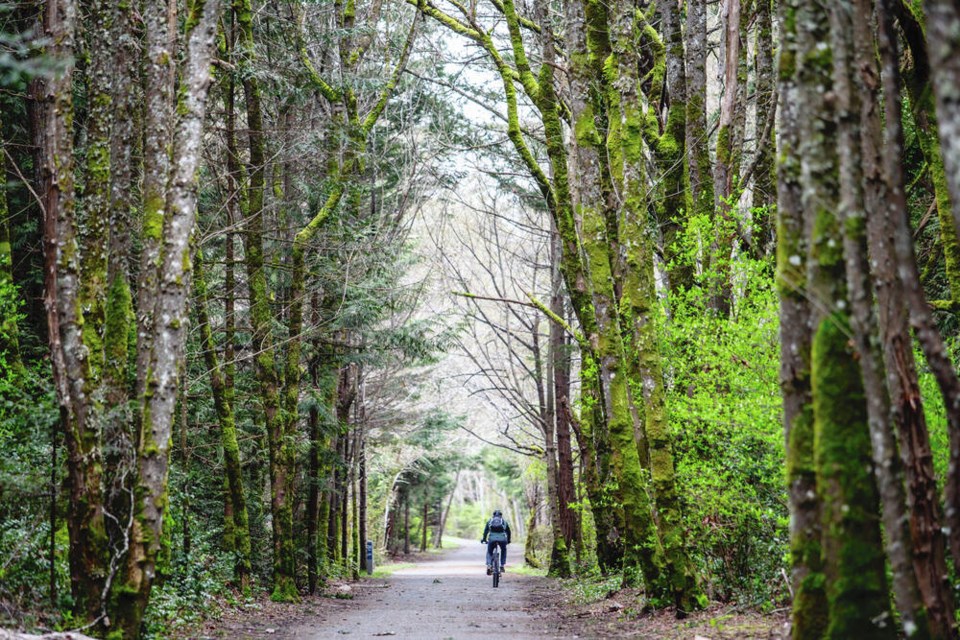Courtesy of Times Colonist
Photo: A cyclist rides on the Galloping Goose Regional Trail near Taylor Road in Metchosin. DARREN STONE, TIMES COLONIST
This is the fourth in the series of columns where I present the recommendations of Livable Victoria, an informal and non-partisan group of which I am a member. We share a commitment to making our region a more sustainable, vibrant, healthy, and inclusive place to live.
Our fourth recommendation is to invest in cycling, transit, and pedestrian infrastructure. This form of mobility is also known as active transportation, for the obvious reason that people getting around on foot, by bike or transit are more physically active. It makes a great deal of sense in a region with a temperate climate, and one that on the whole is not very hilly.
Active transportation is a major focus of public health action, and has been for some decades. The health benefits include increased physical activity (in turn linked to reduced obesity and improved heart health), improved air quality (linked to improved heart and lung health), and reductions in injuries, noise and greenhouse gas emissions.
On the down side, noted Canada’s National Collaborating Centre for Environmental Health in 2010, people using active transport modes “face an increased risk of injury from collisions, [and] may also be exposed to elevated levels of air pollution.” Those risks can be reduced by safely separating cyclists and pedestrians from vehicles, reducing vehicle traffic, controlling exhaust pollution and speeding the transition to electric vehicles.
Our first recommendation is to improve sidewalks, crosswalks, and multi-use paths to ensure that every household has safe walking routes to local schools, parks, urban villages, and community centres. This, of course, fits well with and complements one of the key Livable Victoria recommendations I mentioned last week, namely to create “15 minute neighbourhoods” where people can meet most of their daily needs locally.
Of course, not everyone can walk, bike or take transit, so a second key recommendation is to apply universal design principles so that streets, sidewalks, and roads accommodate all users, including people with mobility impairments and other special needs.
This fits well with the focus of our third recommendation, which is to expand the All-Ages-and-Abilities (AAA) cycling network to ensure all residents have convenient and safe access to the network. People with mobility and other impairments must be able to access all the services and amenities they need, hence the importance of allowing electric-powered wheelchairs and mobility scooters to use the network.
Our final two recommendations are for the region to accelerate the implementation of the Victoria Transit Future Plan, creating a comprehensive and integrated transit network, and to place a moratorium on future highway expansions, reallocating funding to traffic reduction strategies. On a regional scale, we can’t build a good transit system and get people out of cars if we continue to sprawl and build highways. So stopping further urban sprawl — another recommendation highlighted last week — is key.
So too is a re-allocation of public and private investment. In a July 6 Planetizen blog posting, Todd Litman, a member of Livable Victoria and founder of the Victoria Transport Policy Institute, whose research is used worldwide in transport planning and policy analysis, points out that “In a typical community, 20 to 40 percent of residents will rely on non-auto travel options if they are available.”
Yet, he adds, “about 85 percent of spending by departments of transportation is devoted to roadways.” He suggests that we should be allocating 20 to 40 percent of transportation dollars and road space to walking, bicycling, and public transit, or “even more to make up for a century of car-centric planning.”
One final point: It may seem cheaper to live further away from downtown, but that is an illusion, as a 2020 Capital Regional District report found. Total average annual household housing and transportation costs in the core municipalities were lower than for the Saanich Peninsula and the West Shore. Much of that was because “transportation costs tend to be higher in car dependent areas with limited access to services and employment centres.”
Add the social costs of long commutes to that, as well as the related greenhouse gas and other pollutants generated by all that traffic, and it is clear where the benefits lie. Investing in cycling, transit, and pedestrian infrastructure has important health, environmental, social and economic benefits.
thancock@uvic.ca
Dr. Trevor Hancock is a retired professor and senior scholar at the University of Victoria’s School of Public Health and Social Policy

ny5nxp